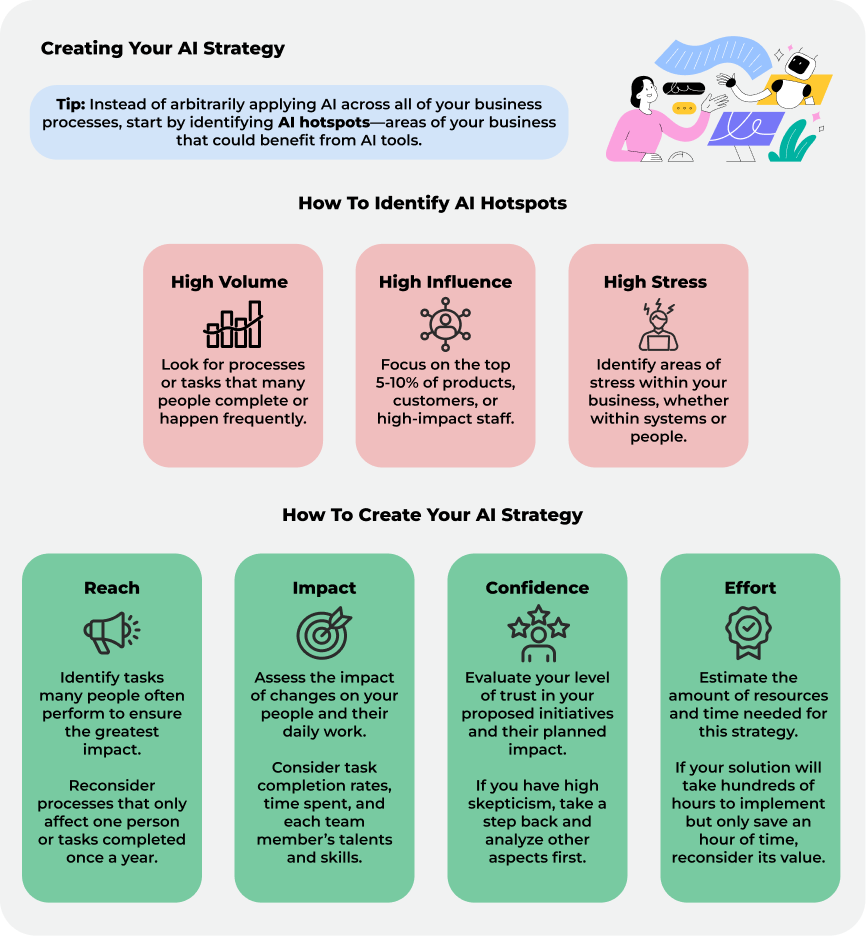AI’s sharp spike in popularity has left business owners scrambling to keep up and integrate it with their key processes and strategies. However, most businesses are taking a backward approach to developing a successful AI strategy.
Over the past several months, I have talked to dozens of businesses that have set directives for their IT team to develop an AI strategy.
This is the point where IT Directors around the globe start researching the capabilities of AI solutions and asking everyone in their network how they use this shiny new tool. Consider this analogy. Think of AI as a hammer and your business processes as nails. Many organizations use AI like a hammer and search for nails in their business. They focus on discovering any area where AI can be used and implementing it for the sake of it.
And, yes, thousands of articles across the internet share how you can incorporate AI into every facet of your business operations, from sales to marketing to HR. Yet, this approach leaves out the most crucial aspect of any strategic initiative: business impact.
Instead of exploring the capabilities of AI solutions, identifying talent and skill development needs, and exploring what others are doing, you should start by examining your business for what we call “hot spots”, or areas most likely to benefit the most from technology initiatives. Now, you can explore how all of the tools in your toolbelt, including your shiny new AI hammer, can have the most significant impact.
In this article, I’ll share the most impactful ways to approach your AI strategy and checkpoints to know whether you’re on the right path.
Getting Started
Currently, many organizations recognize the potential of AI and how it can save time, reduce costs, and free up resources. CEOs may task their IT leaders with creating an AI strategy to ensure they can stay ahead of the competition.
However, knowing where to begin with AI implementation can often be challenging. Businesses may blindly apply AI across all processes without recognizing the associated problems.
Although it’s crucial to stay ahead of the technology curve, it’s not helpful to incorporate AI into every workflow just because it’s possible.

AI is one tool out of many that businesses can use to their advantage. Like any tool, it should be used strategically in ways that make sense.
Instead, you should take the opposite path: start by identifying areas of your organization that could benefit from AI.
How Can I Find “Hot Spots” That Could Benefit From AI?
We’ve already shared the merits of an impact-first approach when developing your AI strategy. We recommend creating a plan focused on identifying potential hotspots for technology initiatives.
But how can you find the areas of business that could have potential “hot spots?”
High Volume:
Look for processes or tasks that many people complete or happen frequently. These items could be in any area of the organization with a high volume of transactions or activities. These are potential “hot spots” because modest improvements can have a major impact when multiplied across all activities.
High Influence
The 80/20 rule states that 80% of the effects come from 20% of the causes. For example, it is common for 80% of a company’s profits to come from 20% of its products or customers. The next way to identify “hot spots” involves going even deeper and looking for the top 5-10% of products, customers, or high-impact staff. You can significantly impact your business by increasing the value of these highly influential areas.
High Stress
Another place to look for hot spots is within stress areas at your business. These stresses could be in your systems or people and are most easily detected from the symptoms they cause.
It could start with service, delivery, or quality issues at your business. These challenges can cause bottlenecks & delays and should be resolved to ensure you can continue providing top-notch service or products to your customers.
To find these issues, you can search for stress within your systems and people. If your systems are affected, tasks typically aren’t getting done and may lead to quality issues. If your people are affected, you may observe signs of stress in conversations or an increase in turnover.
Now that you have identified potential hot spots, it’s important to understand where AI fits in.
How Can AI Help My Business?

Currently, most businesses are considering how generative AI tools using large language models, such as ChatGPT and Bard, can help them. Generative AI is a tool that helps with content creation, reviews, checks, and analysis.
Yet, it’s significant to remember that there are many roles AI can fill beyond text and text creation, like assistance with data. If you feed data into an AI engine, it can recognize and describe patterns or objects, detect anomalies, and more. There are also AI solutions that can interpret audio content and automate workflows.
When deciding how to implement AI, many resources are available to help. These are often categorized by industry, business area, software platform, and more. For instance, if you know that you need help writing blogs, you can search for specific strategies of ways AI can help with this task.
Check out this infographic for inspiration on leveraging AI in your unique industry. For more in-depth information about business use cases, TechTarget and HubSpot recently published articles sharing ways to utilize AI within specific industries.
If you’re looking for particular AI solutions, consider this resource from Data Science Central. The graphic shares examples of AI tools categorized by business need. Whether you’re looking for a tool related to security and risk or customer management, this graphic can pinpoint key solutions to advance your efforts.
Custom AI Solutions
One important note is that it is possible to directly connect to the technologies underlying many AI engines. This strategy opens the door for many creative solutions to develop custom AI solutions that fit easily into your business processes. In many cases, creating a custom AI workflow can provide you with a competitive edge that others in your industry cannot easily replicate.
How should You Create an AI Strategy?
Now that you have identified potential hot spots and understand how AI solutions may help in these areas, it is important to prioritize and focus your efforts on the initiatives that will impact your business the most.
As mentioned previously, AI shouldn’t be arbitrarily implemented throughout your business. On the contrary, it should be used strategically to ensure efforts yield the most significant impact on critical organizational processes.
When prioritizing AI initiatives, we recommend following the RICE method to determine target areas of prioritization.
RICE stands for Reach, Impact, Confidence, and Effort and is an excellent way to drive your business’s strategic AI approach.
Reach
With any initiative, particularly AI, the level of reach is a vital consideration.
If you’re looking to implement AI, start by examining workflows and tasks at your business. To narrow your focus, identify tasks many people often perform to ensure the greatest impact.
Reconsider incorporating AI into processes that only affect one person or tasks completed once a year. These initiatives won’t have an extensive reach and can be deprioritized.
Impact
After analyzing your proposed AI initiative’s reach, consider whether changing this process will have a significant impact. Just because a workflow affects many people does not mean the effect will be correspondingly far-reaching.
For instance, say many people in your organization log into Microsoft 365 each day as part of their daily workflow. While this is something that many employees do frequently, changing the login process wouldn’t necessarily have a considerable effect.
When implementing AI, focus on making changes that will have the greatest impact.
Consider questions like the following when determining the impacts of changing a specific process:
- How many people in my company complete this task?
- How frequently does this task occur?
- How much time is spent completing this task?
- Would there be an impact if this process was better or faster?
Additionally, consider defining the tasks your team could focus on with more streamlined processes. Often, staff members can prioritize more fruitful tasks if tedious or time-consuming workflows are improved.

Confidence
Confidence refers to your trust that proposed initiatives will have the planned impact.
For instance, if you automate invoicing processes, will it reduce the time required to handle the tasks? Or is your current invoicing process complex because of poor data sources? In the latter case, automating the process might not save time if data is incorrect or invalid.
Ensure that you appropriately understand your level of confidence regarding your initiative. If you have high skepticism, take a step back and analyze other aspects of your processes first.
Effort
The last item you should consider regarding your proposed solution is effort. How many resources and how much time will it take to implement this strategy?
If your planned solution will take hundreds of hours to implement but only save an hour of time, reconsider its value. But, if your solution will only take several hours to implement and save hundreds of hours for your team, it may be the right choice.
Ensure that you align your degree of effort with your designated levels of reach and impact.
How Do I Know If I’m on the Right Track with My AI Strategy?
When creating a new strategy, it can be difficult to tell if you’re on the right path. However, AI strategies operate like any other initiative at your business; they all begin with a goal.
Once you’ve completed the steps in the RICE method, you should define a tangible goal for your proposed solution. This goal will drive your implementation process forward and allow you to track associated metrics and their significance.
Above all, ensure you know what you expect to accomplish by implementing AI into your business.
Your goals should pass the High-Five Test, a tool used to evaluate the success of your goals. Can your team members give each other a high-five at the end of the day? Are they proud of the work that they did? Can they accomplish the goal?
You can also consider these goals as SMART goals or KPIs—Specific, Measurable, Achievable, Relevant, and Time-Bound.
For instance, maybe your goal is to cut the amount of time in half that it takes to generate a proposal by leveraging AI. Or, perhaps you expect to reduce the number of issues related to a particular task by 20%.
Consider the following questions when measuring your progress.
- Am I having the impact that I’m expecting?
- Am I on track to accomplish my goal?
- Does the effort that went into this match what was expected?
If the answer to these questions is “Yes,” you’ll be high-fiving your teammates at the end of the day because you accomplished the goal you set out to achieve.
Staying Up-to-Date with AI
Like any technology, AI continues to advance and change. However, as new applications become prevalent, keeping your business goals top-of-mind is essential.
Always review your processes before implementing an AI tool or another new technology. Ask yourself, “Where can I leverage this new tool to create a competitive advantage and improve my bottom line?”
Don’t just implement AI because everyone else is doing it. Instead, evaluate your current processes and determine areas where AI tools can significantly impact your people, streamline workflows, and allow your business to keep moving forward.


